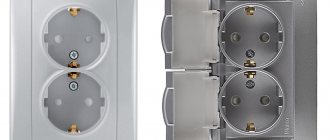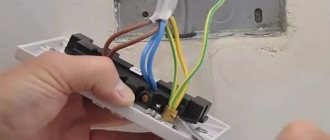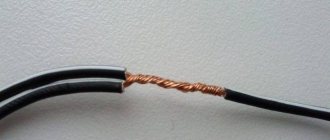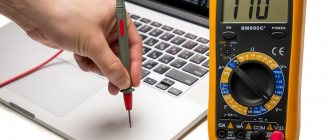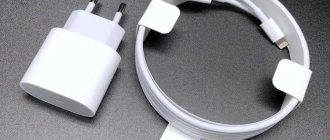What happens to a person when he is electrocuted?
An electric shock can cause problems in the nervous system, such as erratic muscle contractions. Repeated impacts can cause neuropathy. Acute electrical trauma can cause asystole. If the head is hit by an electric current, loss of consciousness may occur.
Interesting materials:
How to install games on PlayStation 4 for free? How to install games on PS3 from a flash drive? How to install games on PS4 from a computer? How to install cache for a game via ES Explorer? How to find out the game ID on Steam? How to find out when you launched the game on Steam for the first time? How to find out who you played with in PUBG? How do I specify the path to the game in Epic Games? How can I bring out Vuzhas in the game my singing monsters? How to get cardamom in the game My Coffee Shop?
A little theory.
Without going into technical details, we can say that a single-phase electrical network is a method of transmitting electric current when alternating current flows to the consumer (load) through one wire, and returns from the consumer through another wire.
Let's take, for example, a closed
an electrical circuit consisting of an alternating voltage source, two wires and an incandescent lamp.
From the voltage source to the lamp, current flows through one wire and, having passed through the filament of the lamp, making it hot, the current returns to the voltage source through another wire. So, the wire through which current flows to the lamp is called phase
or simply
phase
(
L
), and the wire through which current returns from the lamp is called
zero
or simply
zero
(
N
).
When, for example, a phase wire breaks, the circuit opens, the flow of current stops and the lamp goes out. In this case, the section of the phase wire from the voltage source to the break point will be under current or phase voltage
(phase). The rest of the phase and neutral wires will be de-energized.
If the neutral wire breaks, the flow of current will also stop, but now the phase wire, both terminals of the lamp and part of the neutral wire extending from the lamp base to the break point will be under phase voltage.
You can use an indicator screwdriver to make sure there is a phase on both terminals of the lamp and on the neutral wire coming from the lamp. But if you measure the voltage on the same terminals and wire with a voltmeter, it will not show anything, since in this part of the circuit there is the same phase, which cannot be measured relative to itself.
Conclusion: there is no voltage between the same phase. There is voltage only between the neutral and phase wires
.
Advice
. To determine the presence of phase and voltage in the electrical network, it is necessary to use an indicator screwdriver and a voltmeter together. You can use a multimeter as a voltmeter.
Now let’s move on to practice and consider some situations with zero that you can independently determine and, if possible, eliminate without involving the utility service:
1. Zero break in the entrance panel of a house or apartment
;
2. Zero break at the input or inside the distribution box
;
3. Short circuit of the neutral conductor to the phase conductor in case of mechanical damage to the insulation
.
Where and why the second phase may appear
Here we must immediately make a reservation that since only one phase wire enters the apartment, the concept of “second phase” implies that the voltage indicator shows the phase in the contacts on which it should initially be at zero. The second phase, in the correct understanding of these words, cannot exist in an apartment.
The next point that you need to know to understand the essence of the problem is that every electrical appliance is a conductor of electricity. The simplest example is a light bulb - its filament glows due to the fact that it is a conductor of electric current. Essentially, the light bulb shines because it closes phase and zero between each other, but a short circuit does not occur since the filament has a certain electrical resistance. Other devices work in the same way - they are often connected to the network through transformers, the windings of which are made of copper wire. Again, a short circuit does not occur, since due to the length of the wire and its cross-section, it has electrical resistance, but in essence, when a plug of any device is inserted into a socket, the phase and zero are closed in it.
Now it should be clear why there are two phases in the socket - this malfunction can only appear if zero is missing. The phase comes to the socket, passes through the electrical appliance connected to it and appears on the neutral wire, and from it on those sockets that are located after the zero break. Accordingly, if you turn off all the switches and remove all the plugs from the sockets, the indicator will show the phase on only one contact.
As a result, a phase instead of a zero may appear in one separate socket (provided that it is double or triple and a plug of some electrical appliance is inserted into one of the plugs). Further, 2 phases can be in one of the rooms, in half of the apartment, or generally everywhere.
You also cannot discount the possibility of a short circuit, for example, when drilling a wall or poor-quality laying of wires in a junction box. With some luck, you can hook the wiring in such a way that the neutral wire is cut off from the main network and stuck to the phase wire. In this case, the indicator will show two phases in the outlet even when electrical appliances are disconnected from the network.
In this video you can see how this malfunction is reproduced on a specially assembled stand:
Possible cases of zero break in a single-phase home network
A malfunction can occur almost anywhere in the wiring, but most often damage occurs where the electrician made the switching of the circuit wires in:
- apartment distribution board;
- junction box;
- socket.
It is also possible for the wire insulation layer to be destroyed and the neutral wire to break, creating a phase contact.
Zero break in the apartment panel
The malfunction may occur on:
- input circuit breaker;
- electricity meter;
- zero bus.
The cause of the break may be poor contact with the wire due to:
- contamination of work surfaces;
- insufficient clamping force of the screw connection;
- cuts in the metal core of the wire.
Any of them creates increased resistance in the transition section, leading to excessive heating, the formation of soot, which gradually turns into a break.
In this situation, all electrical appliances in the apartment will lose voltage, but the phase will remain present.
If at least one light switch is turned on or a household appliance is inserted into one of the sockets, then the phase potential will pass to the second contact of all sockets through the zero bus.
You will have to inspect possible places of damage and fix the problem.
Zero break in junction box
A fault with a lack of voltage will appear in the room where the distribution box with a broken zero operates. In all other places there will be tension.
Inside the old junction boxes, the wires were connected using twists and wrapped with electrical tape. At zero, it was usually necessary to make more connections, and the overall twist was thicker. From this indirect sign, it is easier to test the circuit to identify zero potential using electrical methods.
A zero break can also occur in the wire connecting the distribution boxes. To replace it, you often need to drill into the wall and replace the cable. To reduce labor costs, it is easier to create a new highway by placing it horizontally and vertically.
Zero break and short circuit to phase in the socket block
This situation can arise when drilling walls, hammering nails, or screwing in self-tapping screws is done incorrectly without taking into account the laid electrical wiring routes, when the integrity of the core insulation is compromised and short circuits and wire breaks occur.
The phase potential will appear on both contacts of the socket without creating additional shunt circuits.
Such a malfunction is eliminated by completely replacing the faulty section of the wiring.
For those readers who are interested in videos on this topic, we recommend watching the work of Sergei Soshchenko: “Two phases in an outlet.”
Zero break in a three-phase network
This is exactly the case when a second phase potential can penetrate inside a single-phase home network and the voltage on all household appliances can jump to a linear value of up to 380 volts.
The culprit of such an accident is most often the electricity supply organization, and all consumers involved suffer from it. Let's consider the option of an air connection to a three-phase input into a private house.
Such wires are located openly. have a great extent. There are many reasons why a phase loss can occur. Their number decreases when connected by an electrical cable hidden in the ground, which is more often used to power multi-story buildings. But the human factor and violation of operating rules should not be forgotten... Zero loss in a three-phase network occurs periodically, it must be taken into account.
Operation of a three-phase network in normal mode
Each apartment with single-phase wiring receives the same phase voltage.
Its value of 220 volts is applied to various resistances of household consumers, which are periodically switched to power randomly. In the circuit, only currents flow from the generator end through the phase wires to the load and return through the neutral wire. The current in zero consists of the sum of three currents of all phases and is usually balanced by them. The voltage in the phases fluctuates within the operating standards.
Types of damage
On the entrance riser
To begin with, let’s take a general look at what the electrical network of a city multi-storey building is. The power source in this case is a transformer substation, from which wires are stretched to the main distribution board of the building. The voltage in the main panel is three-phase, that is, the network is 380 Volts. From here, groups of wires are already output to each apartment. In the apartments themselves, the network is already single-phase - 220 V. If there is a break in the common zero on the entrance riser, this can cause household appliances to fail. This leads to inequality - in a three-phase power supply circuit there will be a phase imbalance and instead of a symmetrical load, an asymmetrical one will be formed, passing through a four-wire circuit.
In simple words, this can be explained this way: from the main panel at the entrance to each individual apartment, the same voltage is supplied - 220 V. If the neutral wire breaks, it may turn out that 300 Volts are supplied to one apartment, and 170 to another (as an example). The result – overvoltage and “undervoltage” will cause electrical appliances to fail. Usually, if damage occurs to the zero, equipment with an engine breaks down: washing machine, refrigerator, air conditioner, etc. In addition, a fire may occur, which is even worse.
What is phase imbalance?
Inside the living space
A completely opposite situation can occur if there is a zero break in a single-phase 220 Volt network, that is, inside your apartment, private house or in the country. In this case, the consequence may be electric shock to a person. This happens because in the socket you will have the same phase on both terminals. Now we will tell you what causes the appearance of the so-called second phase.
From your input panel, the current flows through the phase wire, and since most electricity consumers are constantly connected to the network (the same chandelier), if there is a break, the voltage will go from phase to zero. The result is that there will be an electric current in two openings of the socket. But this is not the worst thing, because... The main danger is that electric shock can occur from any equipment. The reason for this is the incorrect grounding system of the network in the apartment or house. If you connect the “ground” in the distribution panel to the zero bus (which you cannot do), when you touch the grounded body of the household appliance, you will immediately get an electric shock. The consequences, as you understand, can be disastrous. We immediately bring to your attention the correct option for protection against zero loss in the house - a network with a TN-S grounding system:
To sum up the consequences of a zero break in a three-phase and single-phase network, the following should be noted: if the neutral wire on the entrance riser is damaged, the danger will spread to household appliances, and if the working zero in the apartment itself is damaged, the threat will spread to you.
You can see what can happen if the zero wire breaks in this video:
At-a-glance overview of the fault
Determining phase and zero with a multimeter or screwdriver
Multimeter
The device is a combined electrical measuring device capable of performing several functions. The minimum configuration includes a voltmeter, ohmmeter and ammeter. Some modifications are made in the form of current clamps. Both analog and electronic meters are available.
To begin the measurement process, you must switch to AC voltage measurement mode. Measurement is carried out using one of several methods:
- We clamp one of the existing probes with two fingers. We direct the second probe to the contact, which is located in the switch or socket. If the data on the monitor is insignificant (does not exceed 10 volts), we are talking about zero. If you touch another contact, the indicator will be higher - this is a phase.
- If there are concerns about touching the dipstick, there is another way. We direct one of the rods into the socket. With the second rod we touch directly to the wall next to the outlet. The result will be approximately the same as in the case described above.
- There is a third way to measure using a multimeter. We touch the probe to a grounded surface (for example, the equipment body). We touch the surface to be measured with the second probe. If the wire is a phase, the multitester will detect a voltage of 220 volts.
Indicator screwdriver
The indicator is a simple way to determine the phase, accessible even to a person who is doing this for the first time. The test screwdriver looks like a standard one. The difference lies in the internal structure of the indicator screwdriver. The screwdriver handle is made of special transparent plastic. There is a diode inside. The upper part is made of metal.
Note! The indicator screwdriver must not be used for purposes other than its intended purpose. It is not intended for loosening or tightening screws.
Improper use of the test screwdriver will cause its failure.
To find phase and zero using a screwdriver, you need to perform the following sequence of operations:
- Use the end of a screwdriver to touch the contact.
- Press the metal button at the top of the screwdriver with your finger.
- If the LED lights up, we are talking about a phase. If it doesn't react, it's zero.
Note! An indicator lamp rated for 220-380 volts will glow at voltages greater than 50 volts. When working with an indicator screwdriver, it is recommended to adhere to the following safety precautions:
When working with an indicator screwdriver, it is recommended to adhere to the following safety precautions:
- Do not touch the bottom end of the screwdriver while taking measurements.
- Keep the screwdriver clean, otherwise there is a high risk of insulation damage.
- If you need to determine the absence of voltage, first check the functionality of the device, which is definitely under voltage.
Advice! In a DC network, the polarity of the contacts is determined in a very simple way. To do this, simply immerse the wires in a container of water. Bubbles will begin to form near one of the wires - this is a minus. The second wire is positive.
An indicator screwdriver should not be confused with a dialing device. The dialing screwdriver is equipped with batteries. When working with such a device, you do not need to press the button to determine zero and phase, since the screwdriver will light up in any possible situation.
How to find zero with a multimeter
Zero, most often, is found with a multimeter relative to the phase wire, i.e. first, using the method described above, you find the phase, and then, having installed the red probe on it, touch the other conductors and when the tester on the screen shows 220V (+/- 10%), then you will understand that the second wire is zero working or zero protective ( grounding).
It is quite difficult to determine whether a wire is a neutral wire or a ground wire with one multimeter, because in essence, these conductors are one and the same and often simply duplicate each other. In certain grounding systems, neutral and ground are even connected to each other in the electrical panel and it is very difficult to accurately identify them.
The easiest way, in this case, is to disconnect the input wire from the grounding bus in the electrical panel; then, throughout the entire apartment or house, when checking the voltage between the phase and the grounding wires, you will not get 220V, as when checking zero and phase.
It is also worth noting the fact that if differential protection is installed in the electrical panel - an RCD or a differential current circuit breaker, it will definitely work when checking the grounding wires relative to any other conductor, even zero.
Also join our VKontakte group and stay tuned for new materials.
